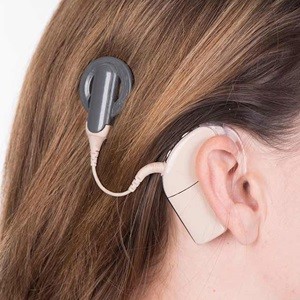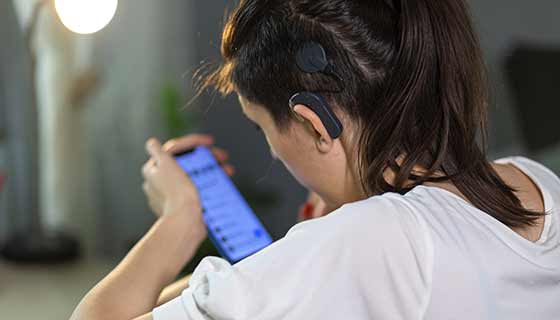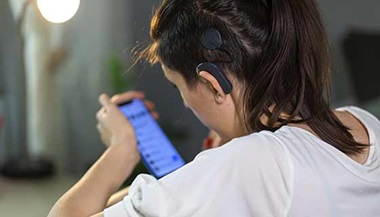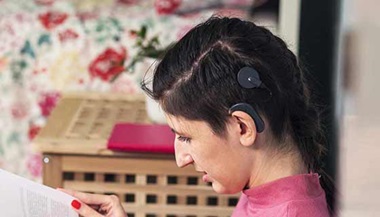Living with a Cochlear Implant
Featured Expert:
After receiving a cochlear implant and while learning to use it, you are likely to have questions. The following are answers to some of the most common questions. You can also consult your surgeon, cochlear implant manufacturer or audiologist for more information. Support communities for people with cochlear implants may have useful tips for improving your quality of life with a cochlear implant.
Cochlear Implant Fit and Comfort
How do I keep my external speech processor behind my ear? It feels like it’s falling off.
Depending on the processor you are using, the options to adjust the fit include:
- Wig tape: The tape can be placed between your skin and the processor. It will adhere to both, keeping the processor secure against your head.
- Earmold: This can be connected to the processor (like a hearing aid) to provide an anchoring point. Using an earmold can also ease the weight of the processor pressing down on your ear.
- Retention devices: Special retention devices that hold onto the processor can be purchased. Search on the internet for “cochlear implant retention.”
My ear hurts from wearing the speech processor. What can I do about it?
Speech processors are often heavier than hearing aids, and ear soreness while using them — especially in the beginning — is common. Moleskin, often used to prevent blisters on feet, can work great on the ear, too. Moleskin patches are available at drugstores in the foot care section. Simply trim the material to the size you need and stick it on the processor.
Cochlear Implant Maintenance and Technical Questions
Can I use an assistive listening device, such as an FM system or a t-coil neck loop, with a cochlear implant?
Yes. All cochlear implants have t-coils that can access the electromagnetic signal from telephones and loops. Also, all cochlear implant speech processors can connect to FM systems and can use the Bluetooth signal from your cellphone to stream information from the phone to your processor.
Where can I get replacement batteries or parts for my cochlear implant?
The cochlear implant manufacturer can ship replacement parts for your speech processor to you. Contact the manufacturer to be sure you are obtaining the correct replacement parts. The manufacturer may be able to bill your insurance directly.
What should I do if my speech processor isn’t working?
If you are having difficulty with your speech processor, start with the steps in the troubleshooting guide that came with the device. You can locate the guide in the instruction manual or access it online on the manufacturer’s website.
If you cannot determine or fix the problem through troubleshooting, contact the manufacturer. The company may have tech support available to help during regular business hours and beyond, while your audiology clinic may have shorter hours.
Lastly, contact your audiologist, who may suggest a repair strategy or schedule an appointment to investigate the problem.
How do I upgrade a cochlear implant?
If you want to upgrade the external parts of your cochlear implant, start by talking to your audiologist, who can help you select the new technology. There may be additional costs to program a new device.
Is there a recommended phone for use with cochlear implants?
No phone is better than others for use with cochlear implants, which can interact with cellphones or smartphones acoustically, electromagnetically and through Bluetooth streaming. Bluetooth is the most common method, since all current cochlear implant processors have Bluetooth functionality.
Living Your Life with a Cochlear Implant
Can I swim while having a cochlear implant?
Yes, but be sure to remove the external processor if it is not waterproof. Some models of external processors have waterproofing options and can be used in the pool, bath or shower. Discuss these options with your audiologist.
The surgically implanted internal processor is underneath the skin and is protected from water damage.
Can I wear a cochlear implant processor while sleeping?
No. The outer part of the device implant is likely to come off during sleep and could be damaged, so you should remove the external portion before going to bed. If you live alone, additional assistive listening devices can help alert you to emergencies.
Can I fly in an airplane with a cochlear implant?
Yes. You’ll need to carry your cochlear implant identification card with you to show security personnel, because you will set off the metal detectors. Most people who had cochlear implant surgery without complications can fly within a week or two of the procedure, but it is always best to confirm that with your surgeon.
What should I do if I lose the speech processor?
Warranties may cover loss for a speech processor, but they have limits. Immediately contact your audiologist, who can help determine if you are covered and assist with completing paperwork to file a claim.
The Johns Hopkins Cochlear Implant Center

The Cochlear Implant Center offers a comprehensive approach to cochlear implantation and rehabilitation, including one-on-one therapy to help patients learn to use cochlear implants. We perform hundreds of cochlear implant surgeries each year on adults and children, lead clinical trials and provide state-of-the-art care.
MRI with a Cochlear Implant
Although MRI is often the best technology for imaging tumors, joints and other soft tissues, there are concerns regarding the test for people with a cochlear implant. The MRI images immediately around the internal magnet will be distorted. With most cochlear implant models made after 2019 and with some older models, MRI is possible, but it requires precautions. You and the doctor ordering the MRI should discuss the benefits and risks of performing the test.
In general, an MRI should not be performed unless your doctor has determined that it is essential for making a diagnosis and that another type of imaging would not be sufficient.
Alternatives to MRI for Patients with a Cochlear Implant
Other imaging tests, such as ultrasound and regular X-rays, do not pose a problem for people with a cochlear implant ― simply removing the external equipment is all that is necessary.
Likewise, CT scans, which provide good images for bones, the lungs, blood vessels and the gastrointestinal tract, usually require no special precautions for a patient with a cochlear implant.
What can happen if a person with an MRI has a cochlear implant?
Receiving an MRI can cause mild to moderate discomfort and warmth at the site of the device magnet. In rare cases, the interaction of the MRI with the device magnet makes completing the test difficult or impossible due to:
- Pain
- Cochlear implant movement
- Reversal of magnet polarity
- Magnet or device extrusion (coming out of the skin)
- Cochlear implant failure that requires surgery, possibly including replacement of the cochlear implant
Preparing for an MRI When You Have a Cochlear Implant
You and your care team can take steps to maximize safety and comfort if you need an MRI, such as removing the magnet or binding or wrapping your head before the test.
Notify the MRI team and bring documentation about the following:
- Make sure you know the exact model of your cochlear implant (this can be different than the external devices that are part of a cochlear implant system).
- Let the person scheduling the MRI know that you have a cochlear implant and ask them to notify the MRI radiologist and technologist and advise them to review the implant manufacturer’s website beforehand.
- Print information from the implant manufacturer’s website and give it to the MRI technologist or radiologist on the day of your scan.
Removing the Cochlear Implant Magnet
All manufacturers recommend removal of all external parts of a user’s cochlear implant system before entering an MRI suite. In some cases, receiving an MRI requires prior surgery to remove the magnet and another procedure to re-insert the magnet afterward. Magnet removal and replacement can be done in a clinic or operating room, but there is a risk of infection, failure of the skin to heal and loss of the implant.
Cochlear Implant Binding
Cochlear implant binding is a way to prepare for an MRI without removing the magnet. While most cochlear implant models made since 2019 can permit MRI scanning without magnet removal, older cochlear implants may have a magnet that requires a head bandage or binder to keep the magnet from flipping.
If this is your first MRI with your cochlear implant in place, you will be provided a small disk for the binding. If you had a previous MRI, please bring your disk(s). For magnet localization, please bring your external processor. Remember that before entering the MRI suite, you must remove the external processor and leave it outside.
What if I can’t tolerate the MRI?
Some patients are unable to tolerate the wrapping or imaging due to discomfort, claustrophobia or both. Taking an over-the-counter analgesic such as ibuprofen or acetaminophen can help minimize pain.
If you think you may need an anti-anxiety medication, obtain it in advance from the practitioner ordering the MRI scan. The person doing the binding will not be able to provide this prescription, and you may need to reschedule the test.







